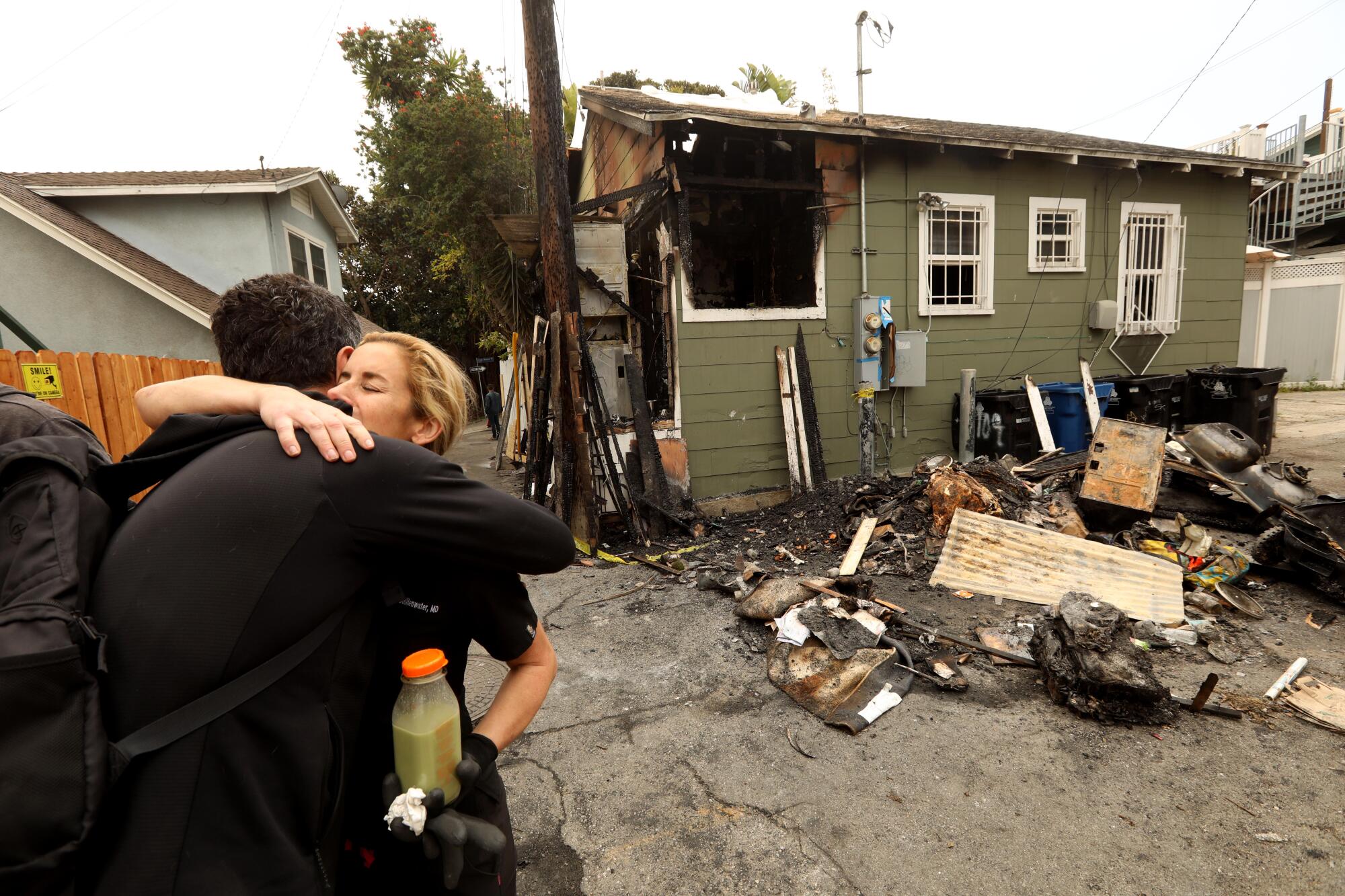
- Share via
The fire began at 3 a.m., quickly destroying the clapboard bungalow two blocks from Venice Beach. The tenant was away for the night, but her dog, Togo, succumbed after his howls of panic and pain left helpless neighbors with a memory they can’t forget.
While arson investigators have yet to determine a cause in the April 20 blaze, traumatized neighbors quickly linked it to a rash of fires in Venice’s growing homeless camps.
“We may never know for sure what happened,” next-door neighbor Francesca Padilla wrote in an impassioned email to dozens of city officials. “What we know for sure is that around my home and the school across the street from it there are people cooking on sidewalks and RV kitchenettes, burning fires to keep warm, using generators for electricity, living out of their cars, smoking and using drugs in makeshift shacks and tents.”
The angst in Venice is part of a widening tableau of fear, anger and tragedy that has become an everyday consequence of homelessness across Los Angeles.
As the number of tents, makeshift shelters and campers on Los Angeles streets has surged, so has the scourge of fire. In the three years since the Los Angeles Fire Department began classifying them, fires related to homelessness have nearly tripled. In the first quarter of 2021, they occurred at a rate of 24 a day, making up 54% of all fires the department responded to.
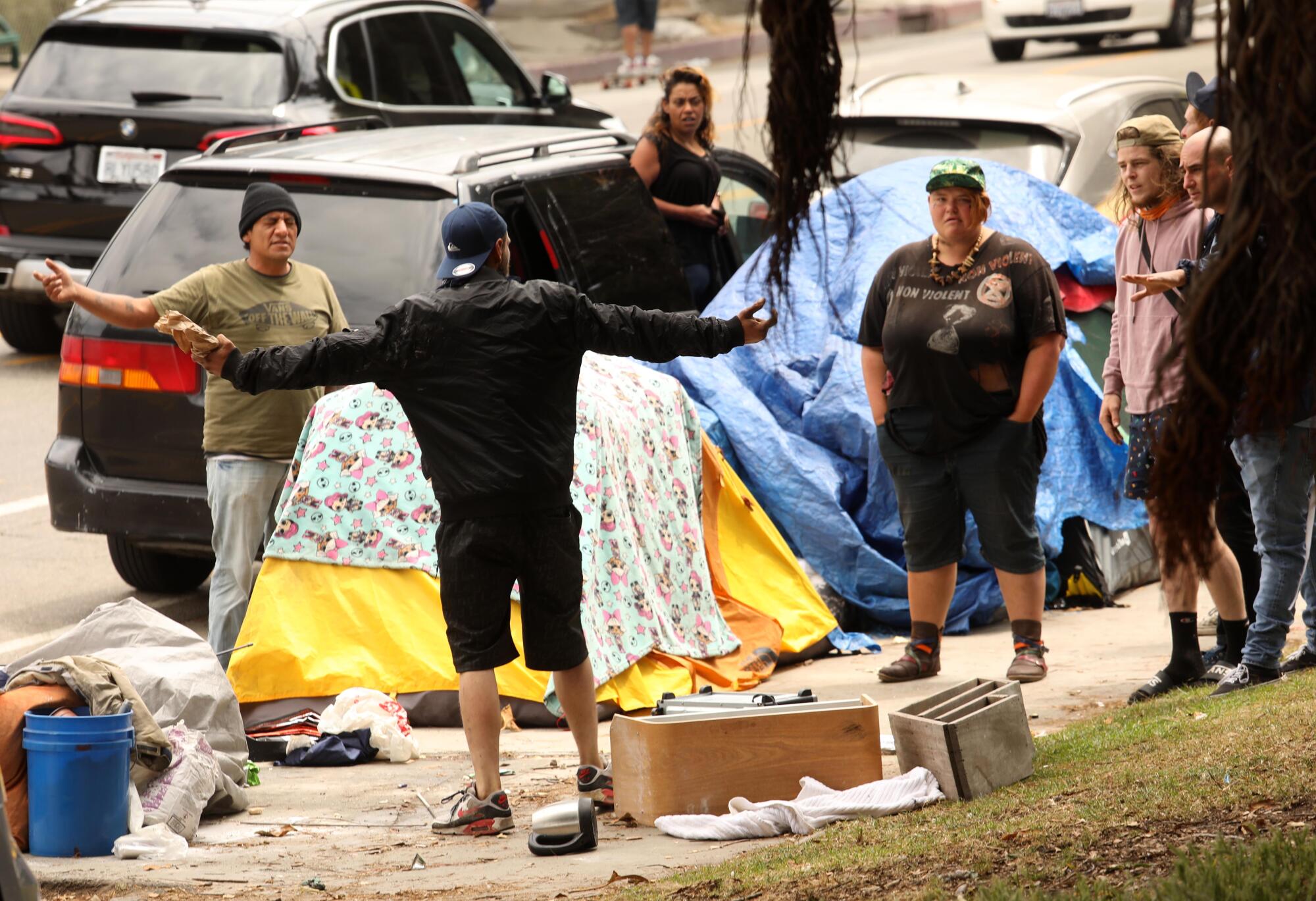
Many of the fires are limited to dumpsters and piles of trash, and the most common outcome is the destruction of tents or other shelter. A few are costly and tragic. Seven homeless people died in fires in 2020. Fires starting in camps lined beside businesses have caused tens of millions of dollars in damage, according to the Fire Department.
The epidemic of fires is largely attributable to the built-in conditions for combustion in street camps — cooking stoves and campfires in close proximity to tent fabric and piles of other flammable material. But social stress is also a factor: A third of the 15,610 fires related to homelessness in the past 3 ¼ years were classified as arson.
Impossible to quantify is the dread, hostility and loss of faith in government brought on by the surge in fires. Business owners are left wondering if a random blaze will scar or destroy their property. For homeless people, the fear is much starker, as a fire could swallow up what little they have left.
Activists and unhoused people have questioned the city’s commitment to solving the issue. At several encampments, The Times spoke to residents who said L.A. firefighters asked few, if any, questions when responding to blazes with unknown causes.
Mel Tillekeratne, the founder of a mobile shower program that aids encampments throughout L.A. County, said the city’s inability to stem the fires reflects most Angelenos’ indifference
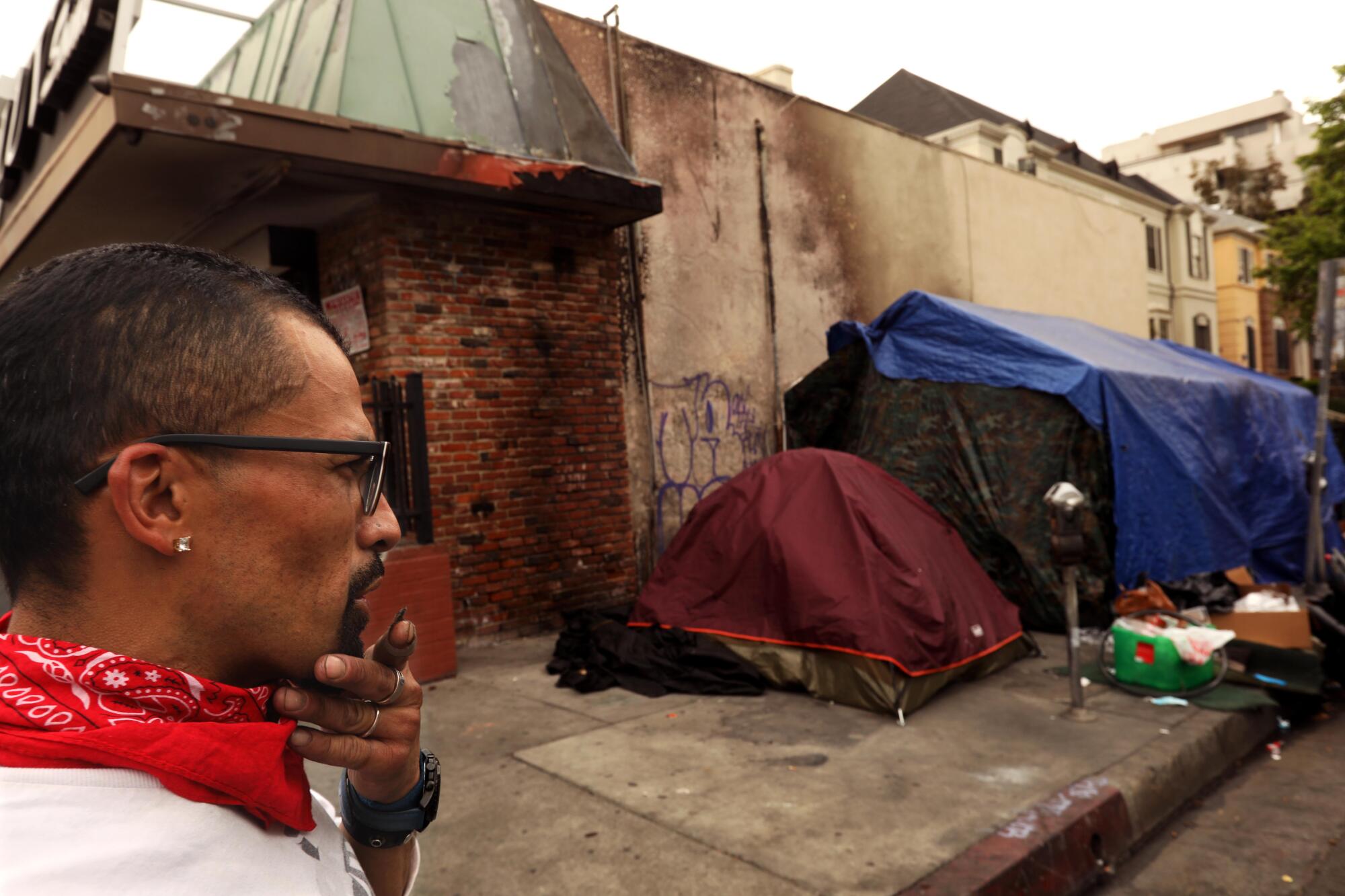
He pointed to photos of a massive plume of black smoke and bright orange flame swallowing entire sections of an encampment at 6th and Berendo streets in Koreatown, the site of repeated fires in recent weeks.
“If it was happening to a different demographic, it would be viewed differently,” Tillekeratne said. “Unfortunately, when it’s a person sleeping in a tent, it doesn’t count as a human being.”
Property owners whose buildings have been threatened by fire also complain of neglect by the city.
“What is it going to take for the City to start protecting the taxpaying businesses in your district?” Mitch Blumenfeld, the chief operating officer of Acme Display Fixture Co. emailed Councilman Curren Price in February, a day after a fire classified as homelessness-related reduced a nearby brick building to rubble.

Tents attached to Acme’s block-long building on Broadway south of downtown have been the source of six fires that have scorched its walls and pitted the bricks, most recently in March.
Blumenfeld wanted to install a sprinkler system that would water the roof and the sidewalk in case of fire, but said his contractor advised him that the plan would not pass city code.
“WHEN IS SOMETHING GOING TO BE DONE?” he wrote.
It’s a question city officials cannot answer.
The rising incidence of fire further exacerbates the city’s dilemma in balancing residents’ security and quality of life with the constitutional rights of those who have no home.
A number of arson attacks on Los Angeles’ growing homeless community have left several people dead or injured in recent weeks, and Los Angeles fire officials say the overall number of blazes affecting the homeless community is on pace to rise for the third year in a row.
In response to questions from The Times, Jose “Che” Ramirez, deputy mayor for city homelessness initiatives, said that “years of litigation and a growing number of court injunctions have significantly limited the City’s legal right to dismantle unsafe structures, or enter encampments to remove the hazardous items causing many of these fires.”
Ramirez said he now favors resumptions of the cleanups that “enabled us to identify and address threats to public health and safety” before being curtailed by the COVID-19 pandemic.
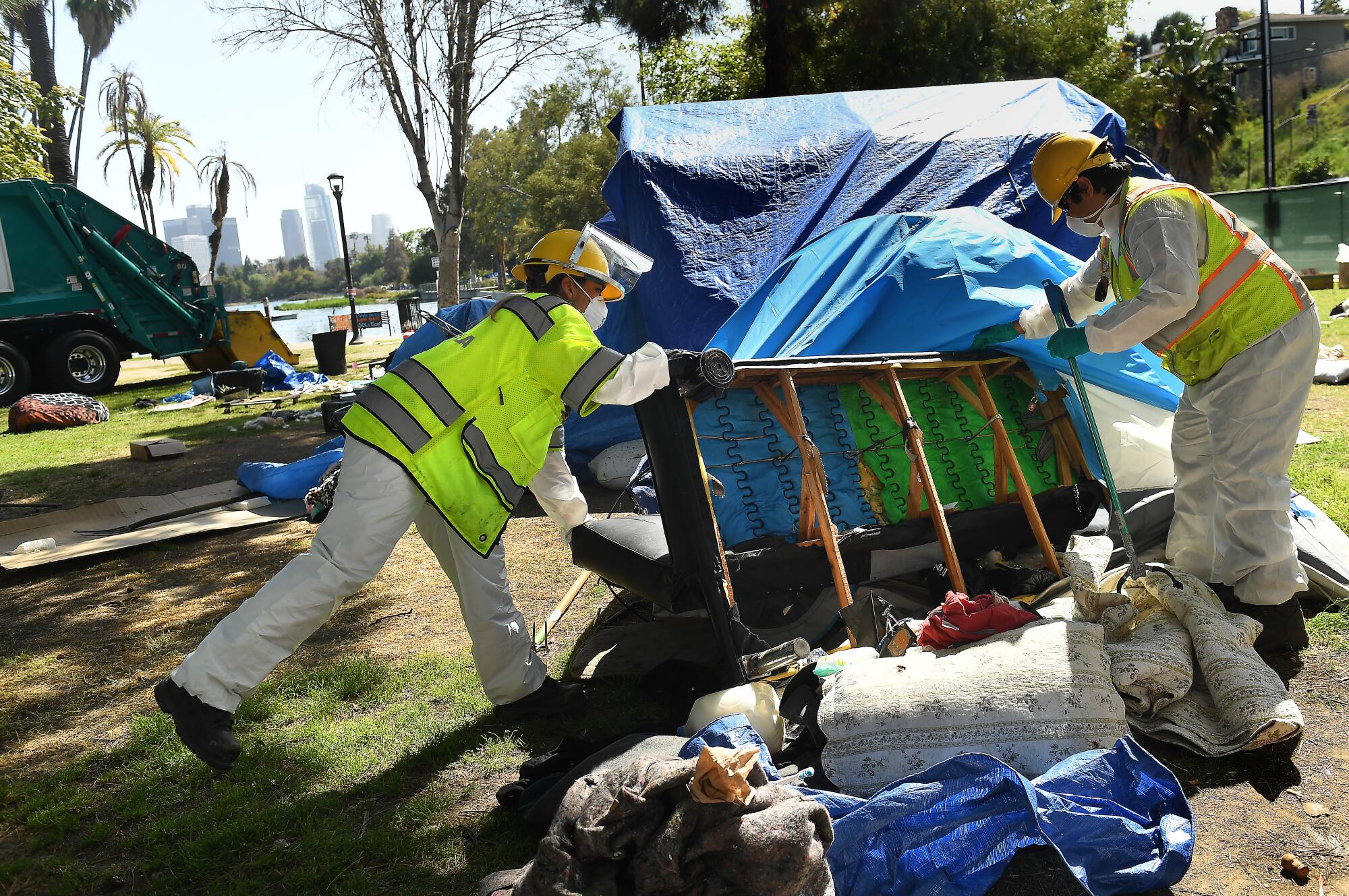
In a few high-profile actions, the city has removed large encampments from public property after offering those living in them alternative shelter. But a court ruling that has been upheld by the Supreme Court holds that homeless people have a constitutional right to camp on sidewalks if the city cannot provide an alternative place to live.
A case being heard in federal court in Los Angeles is probing a key question left open in that ruling: How many shelter beds would the city have to provide to begin enforcing its anti-camping laws at hundreds of locations around the city? At the least it would be thousands, and the timetable remains unknown.
Fire officials say they combat the problem as best they can by sending teams from all 106 fire stations to look for hazards, including in homeless camps, and address any they find. But they have no authority to prohibit essential activities such as cooking, and they have too few resources to inspect every camp.
Those who work to better the lives of homeless people say the surge in blazes has its most devastating effects on homeless people themselves.
“It takes a toll,” said Justin Szlasa, an organizer with the nonprofit SELAH collaborative. Homeless fire victims lose “literally everything that they’ve had with them on the street, which includes where they’re sleeping, their clothes, often documents that are necessary to access services.”
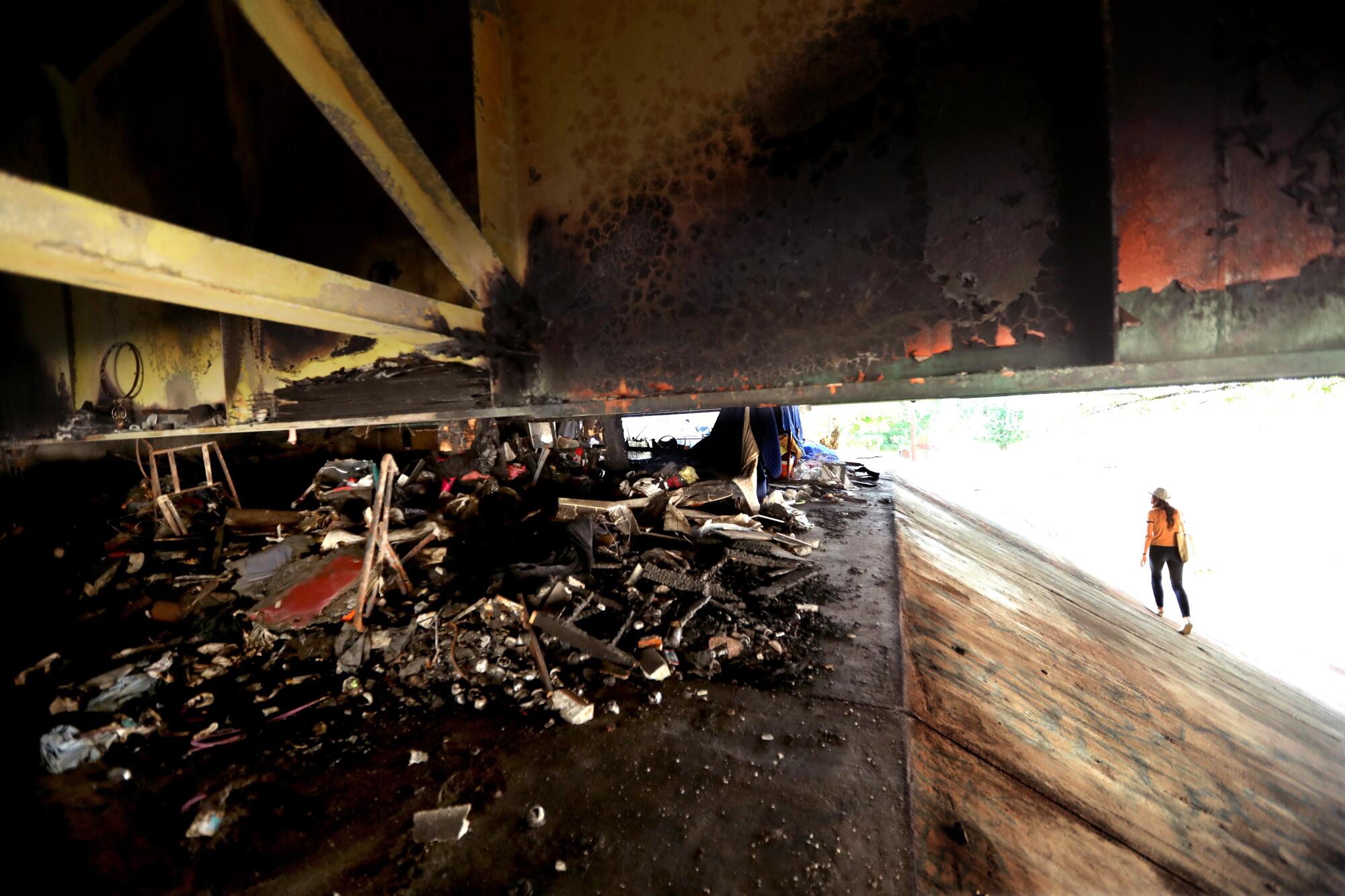
The smell of smoke still hangs in the air near an encampment under the 2 Freeway in Atwater Village, where residents say a pair of raging fires in the past month burned out the spaces where as many as four people slept beneath the metal belly of the overpass. Blackened debris, scorched wood and a discarded propane tank remain at the top of the concrete slope, and residents said at least one homeless man seriously injured his foot running away from the roaring blazes.
“We were screaming at the top of our lungs for everybody to get out,” said one resident of the encampment, who requested anonymity for fear of reprisals. “There were things, like, exploding. … It was terrifying.”
In spite of the danger, the person said they had no plans to move on from the encampment or to give up what little sense of community they had beneath the freeway.
“I don’t have anywhere else to go,” the person said. “I don’t want to be an inconvenience to the community. But there’s only so much we can do.”
Fire is implicated in a small but persistent fraction of the more than 1,000 deaths recorded among the homeless population each year. Most are attributed to myriad health issues and exposure. According to Los Angeles County coroner’s office records, 41 homeless people have died of burns or smoke inhalation since 2015, sometimes in combination with other causes.
Of last year’s seven fire-related deaths, three were ruled accidents, two suicides and two homicides. Three homeless people have died so far this year in fires ruled to be accidental.
The fire hazards related to homeless camps came dramatically into focus after the 2017 Skirball fire was traced to a cooking fire in a ravine near Sepulveda Boulevard. The blaze spread through Bel-Air, destroying six homes and damaging a dozen others.
In response, Mayor Eric Garcetti set up a task force of fire and police officials and the Los Angeles Homeless Services Authority to find homeless camps in severe fire zones and post notices for them to be abandoned.
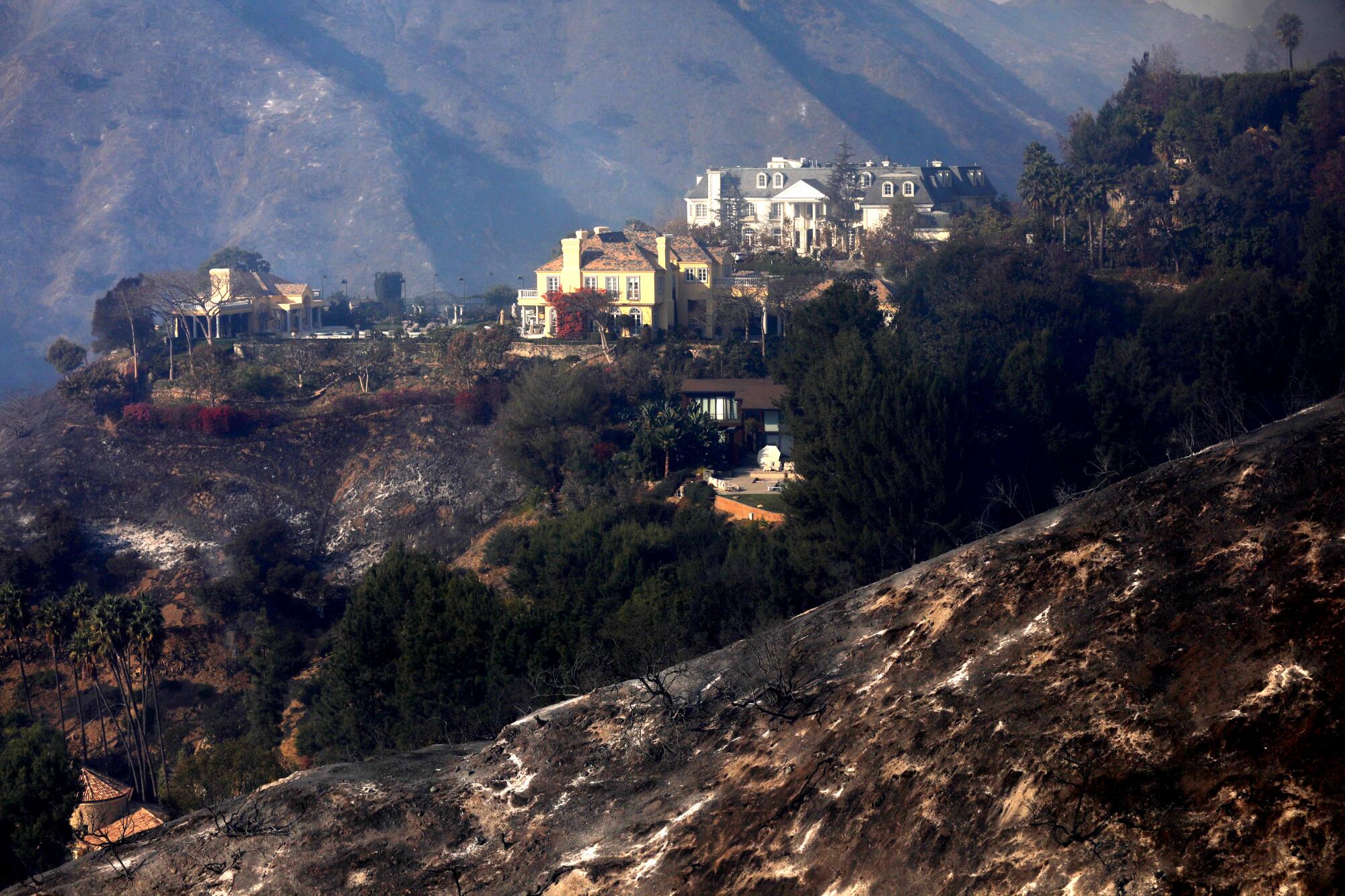
That same year, the Fire Department began noting in reports whether fires were “homeless-related.”
A Times analysis of records shows that fires related to homelessness have doubled in all of the department’s 14 districts since 2018, the first year of complete records. The fires were most prevalent in downtown and South Los Angeles. But the numbers were also elevated in a swath across the north side of the city from Northeast Los Angeles to the east San Fernando Valley.
Many fires related to homelessness are intentional.
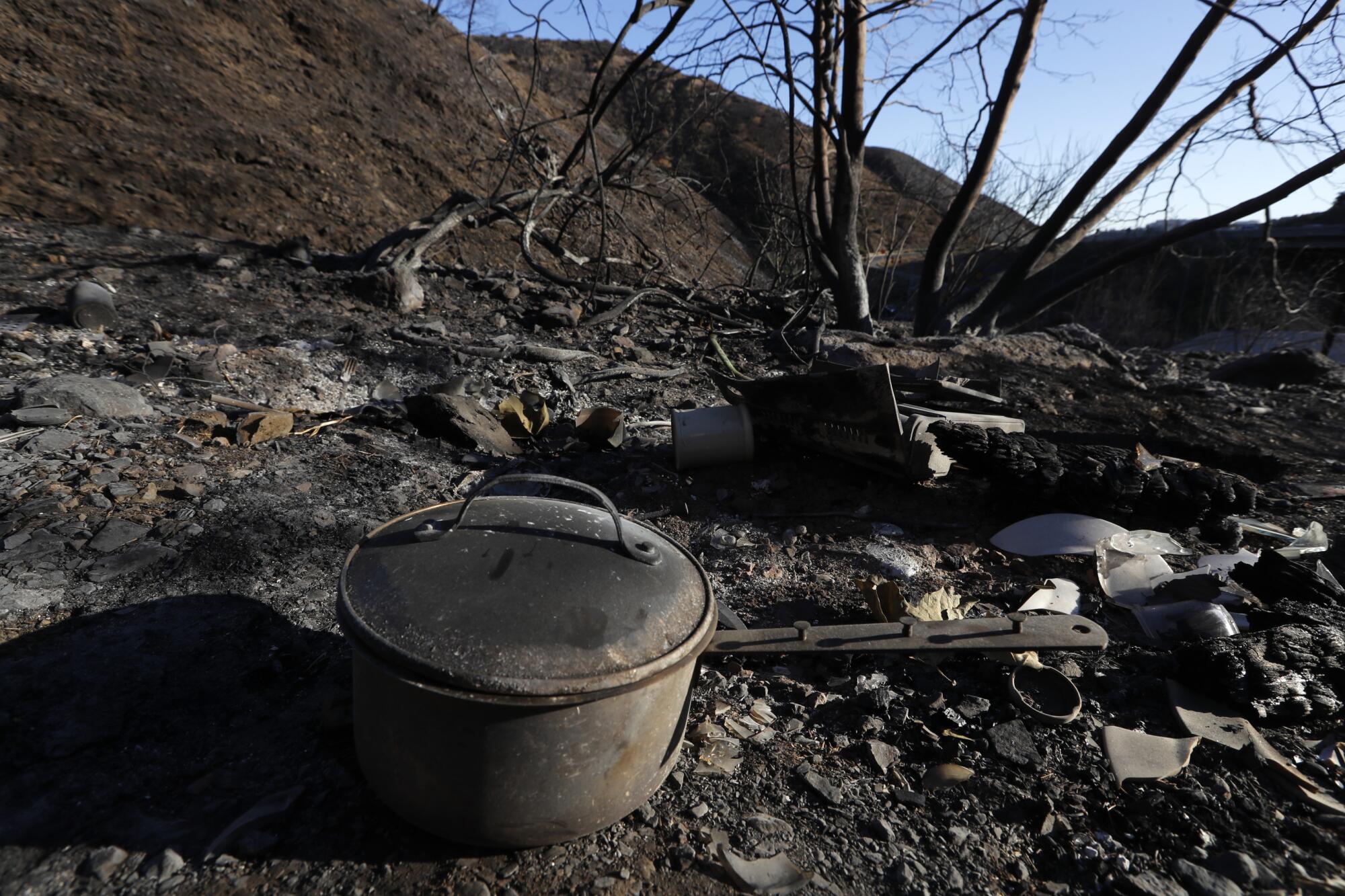
Over the three years, such fires classified as arson have steadily comprised about one-third of the total. As fires related to homelessness have increased, though, the raw number of arson fires has more than doubled, to 2,258 last year — about one of every six fires in the city. Arrests are rare — 129 and 174 over the past two years, a clearance rate of about 6%.
Some of those fires are attacks on homeless camps by outsiders.
In 2019, 27-year-old Daniel Nogueira allegedly threw a firework into a large encampment under the 2 Freeway in Eagle Rock, sparking a brushfire that prompted evacuations and led to injuries to homeless people and firefighters. Nogueira has been charged and is awaiting trial.
Also that year, someone lobbed a Molotov cocktail into a Chatsworth encampment where at least 15 people normally slept, destroying a number of tents and donations recently dropped off by a local pastor.
Though few arsons are solved, limited evidence suggests that the perpetrators are most often other homeless people. Three-fourths of those arrested identified themselves as homeless.
Los Angeles Police Department Capt. Bob Long, who leads the Major Crimes unit that handles criminal arson investigations, said most instances of fire attacks at encampments stem from disputes between homeless people. The sheer number of fires, and the danger of attacks from outsiders as in the Eagle Rock case, have Long unnerved.
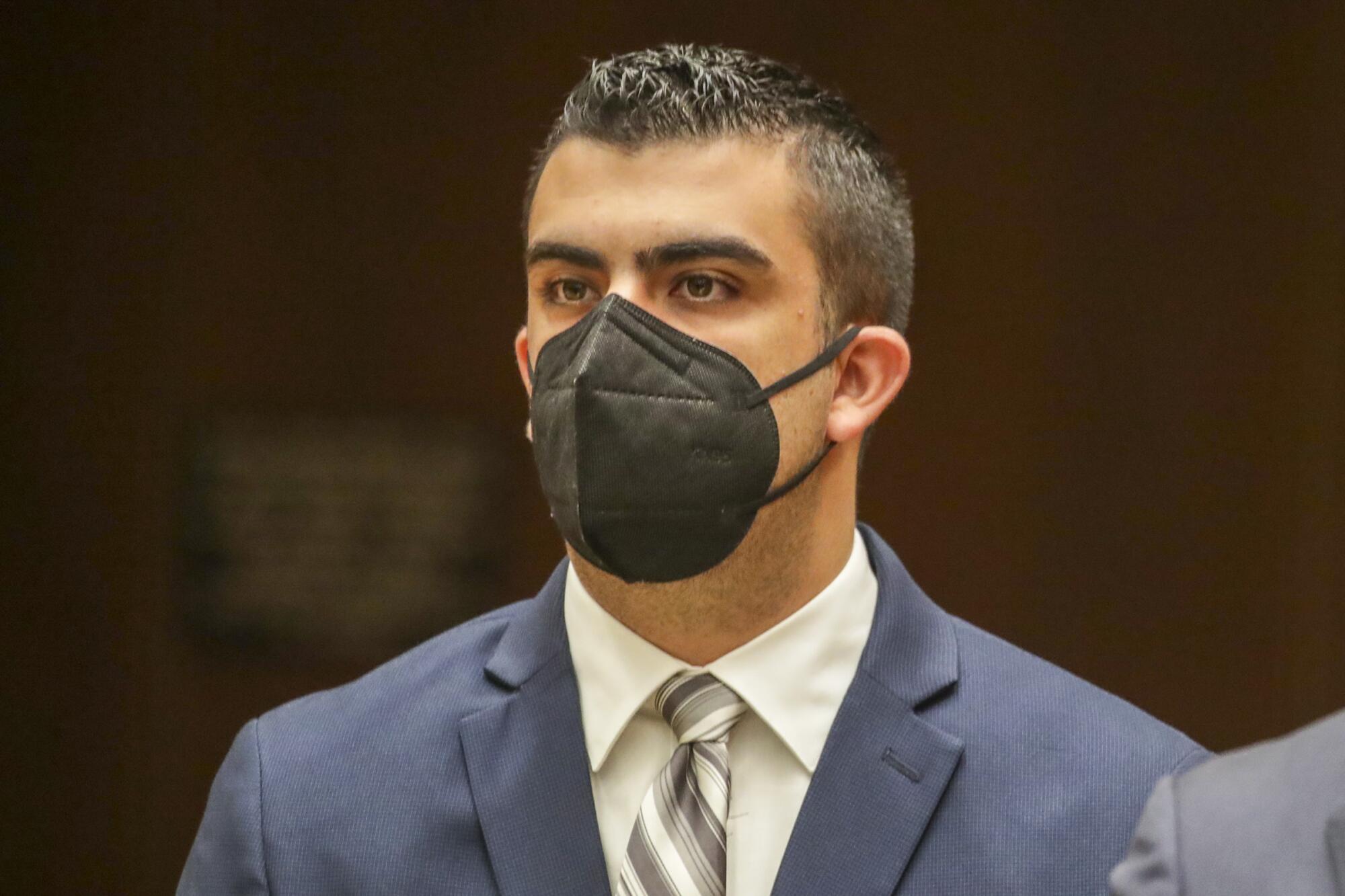
“You can see it driving down the freeway, right? I never used to see fires all the time. Now I see lots of smoke at the encampments. It’s not uncommon for me to see a fire a day, coming into work,” Long said.
Standing near the collection of tarps he strung together on a bike path between the bed of the Los Angeles River and the 5 Freeway, a homeless man who goes by the street name KnowOne shook his head as he recalled waking up last November to find his tent on fire.
KnowOne isn’t sure who set the fire, or why. He says he has enemies at nearby encampments, and activists and other area residents say a street gang named the Rascals has attacked homeless people in the past. But other than his own suspicions, KnowOne said there hasn’t been much in the way of an investigation. He said Los Angeles firefighters did not ask him any questions when they responded to the scene last year. Investigators from the LAPD haven’t been by either, he said.
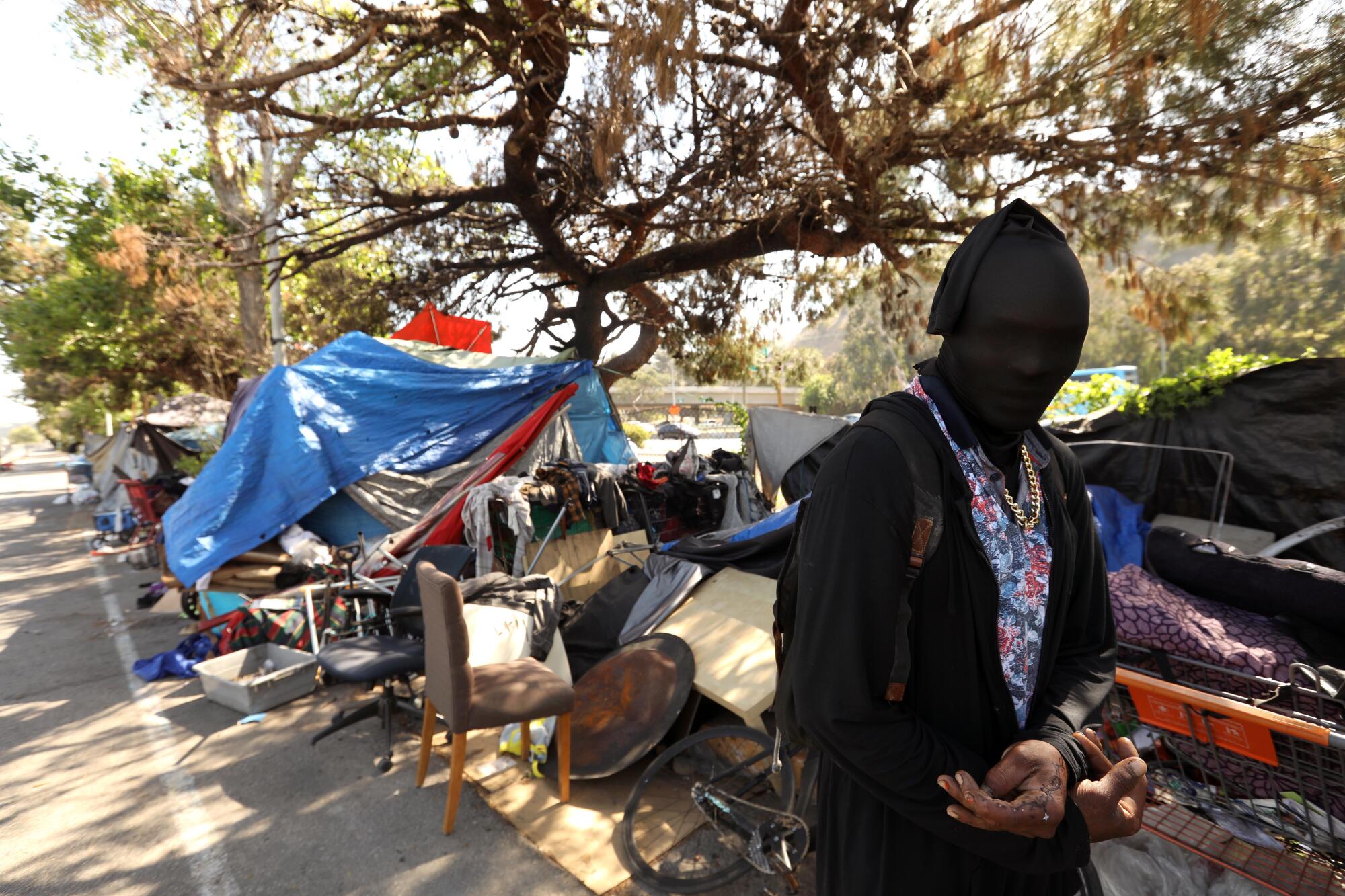
Long said the difficulty in making arrests in such cases comes down to limited resources and city rules about what triggers a criminal investigation. Between the LAPD and LAFD, there are only 24 dedicated arson investigators in the city, Long said.
On average, Long said, the LAFD’s arson unit only refers about 30 cases to the LAPD each year, usually when a fire has caused significant property damage or when firefighters believe a victim was intentionally targeted.
“Honestly, the resources are just not there to do a full investigative backstory on every single fire, as to what was the motive to start the fire,” said LAFD Capt. Patrick Leonard, who heads the agency’s arson and counterterrorism unit.
Leonard said he is compiling records for a report he expects to produce in the next few weeks on the total cost to buildings and their contents of fires related to homelessness.
Preliminary results from that study released by the Fire Department show that such fires have caused $185 million in damage since 2017, 22% of all fire damage in the city. That includes $80 million in damage last year and $12 million in the first quarter of 2021.
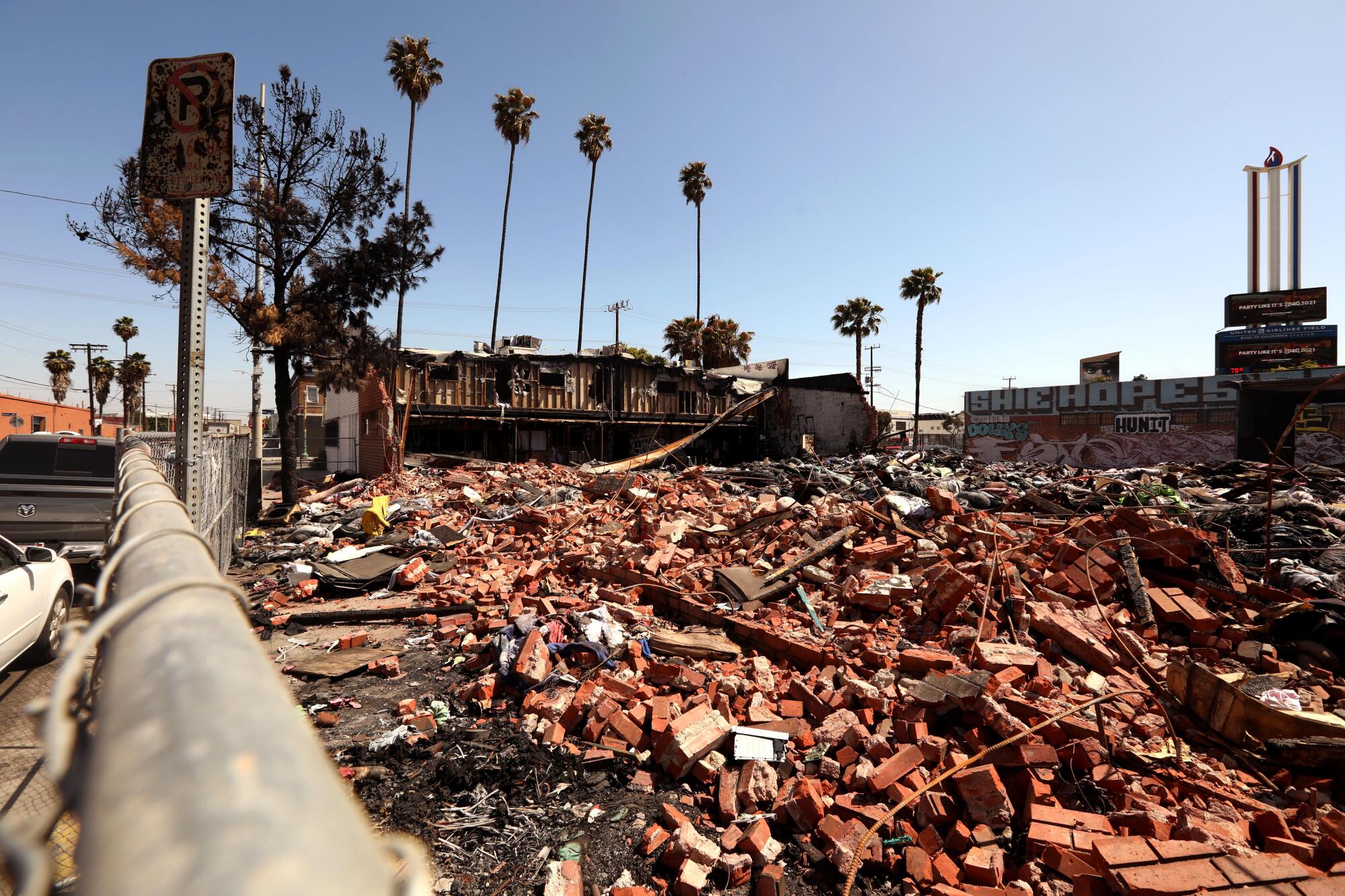
A fire started last August by a homeless person destroyed $1.5 million worth of merchandise in a warehouse south of downtown owned by New Tech Display, said its co-owner, Suzanna Naylor. A building destroyed on 38th Street — the fire near Acme Display— caused $2.5 million in damage, according to a Fire Department estimate.
Besides harming business, some of those costs may fall on taxpayers.
Naylor said she was turning the matter over to her insurance carrier. But others believe the city should be responsible for any damage.
The owner of an office building on the Venice boardwalk that was destroyed in January by a fire that started in a tent has filed a claim against the city, the first step leading to a lawsuit.
The Leo Baeck Temple has sued the city over damage to its buildings and grounds from the Skirball fire, contending that authorities knew about the encampment with its open-air fires and were negligent in allowing it to stay on public property. The case is still pending.
In a letter accompanied by a list of 20 recent fires, a law firm representing several businesses on the Venice boardwalk accused the city of “extreme negligence” and warned that “the occurrence of future fires is inevitable ... due to the city’s refusal to adopt ordinances and/or policies that would mitigate the fire danger to my clients’ property.”

In February, the Venice Neighborhood Council called on the City Council to pass an ordinance prohibiting tents and temporary structures within 20 feet of lot lines and banning flammable-fuel equipment in tents.
The April 20 house fire in Venice elevated the concern from property damage to life safety.
Although the Fire Department has not yet determined the cause, residents of the tightly packed bungalows west of Westminster Elementary School were already on edge about people they believed to be homeless hanging out in their narrow alleys and walkways after midnight.
Then, one morning, a neighbor who asked that his name not be used for fear of retaliation found the remnants of a fire on his parking space and had a realization.
“It’s the fires that will kill us,” he said. “The fire is just a whole other level of fear.”
It was only days later that the house across the alley burned.
“I thought 100% we were going to lose our house,” he said. “We’re packing up our more precious possessions to put them in storage. It could easily be us next.”
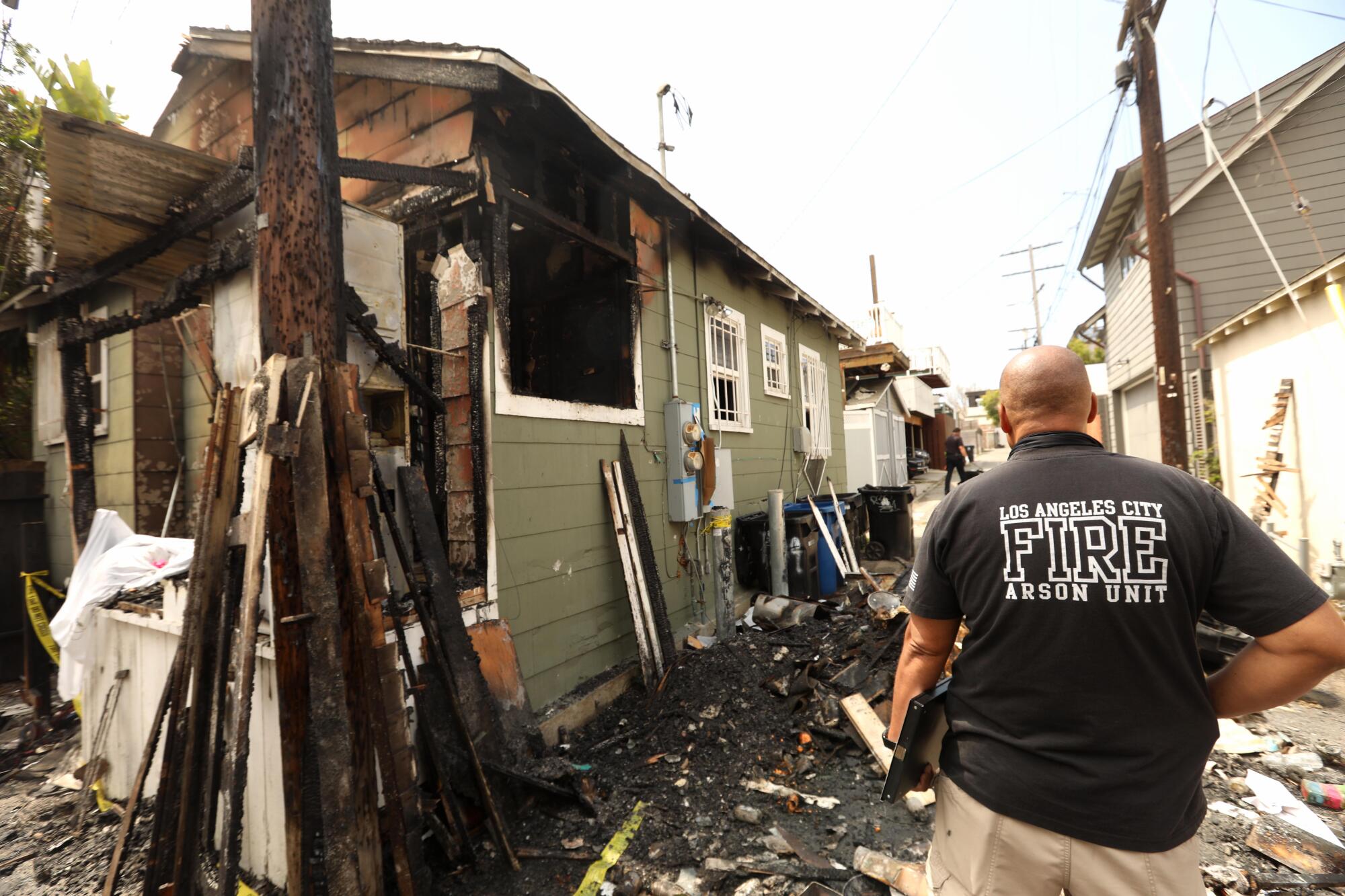
The tenant, pediatrician and Navy veteran Courtney Gillenwater, remained safe that night because she was staying with a friend. She had befriended several homeless dog owners at the nearby dog park and was sure it couldn’t have been them.
They came to see her the next morning and told her they would find out who did it.
“They were furious,” she said.
At one point, someone accused a person who was new in the camp on Main Street. He became combative and was handcuffed by police but later released. There is no suspect.
For Venice activists, the root cause is the city’s failure to address the homeless camps.
“All this calamity, all this cost, all this devastation and destruction to our neighborhood, all this degradation of safety and quality of life because you could not move 20 people out of the park,” Venice resident John Betz emailed Councilman Mike Bonin, Garcetti, City Atty. Mike Feuer and other city officials after the April 20 fire. “I have no idea what you have to say for yourselves. You disgust me.”
“It’s sadly unsurprising that as homelessness and homelessness encampments dramatically increase that fires related to homelessness have increased,” Bonin, who represents Venice, said in an interview. “The obvious answer and the hardest answer is we have to get people out of encampments and into housing,”
In the meantime, Bonin said, the Fire Department has launched a pilot program to station a rapid response team in Venice. A fire engine and crew will work directly with businesses, homeowners, renters and homeless people to reduce fire hazard, Bonin said.
Elsewhere in the city, even those who are generally sympathetic to those they refer to as their “homeless neighbors” have become alarmed by fire.
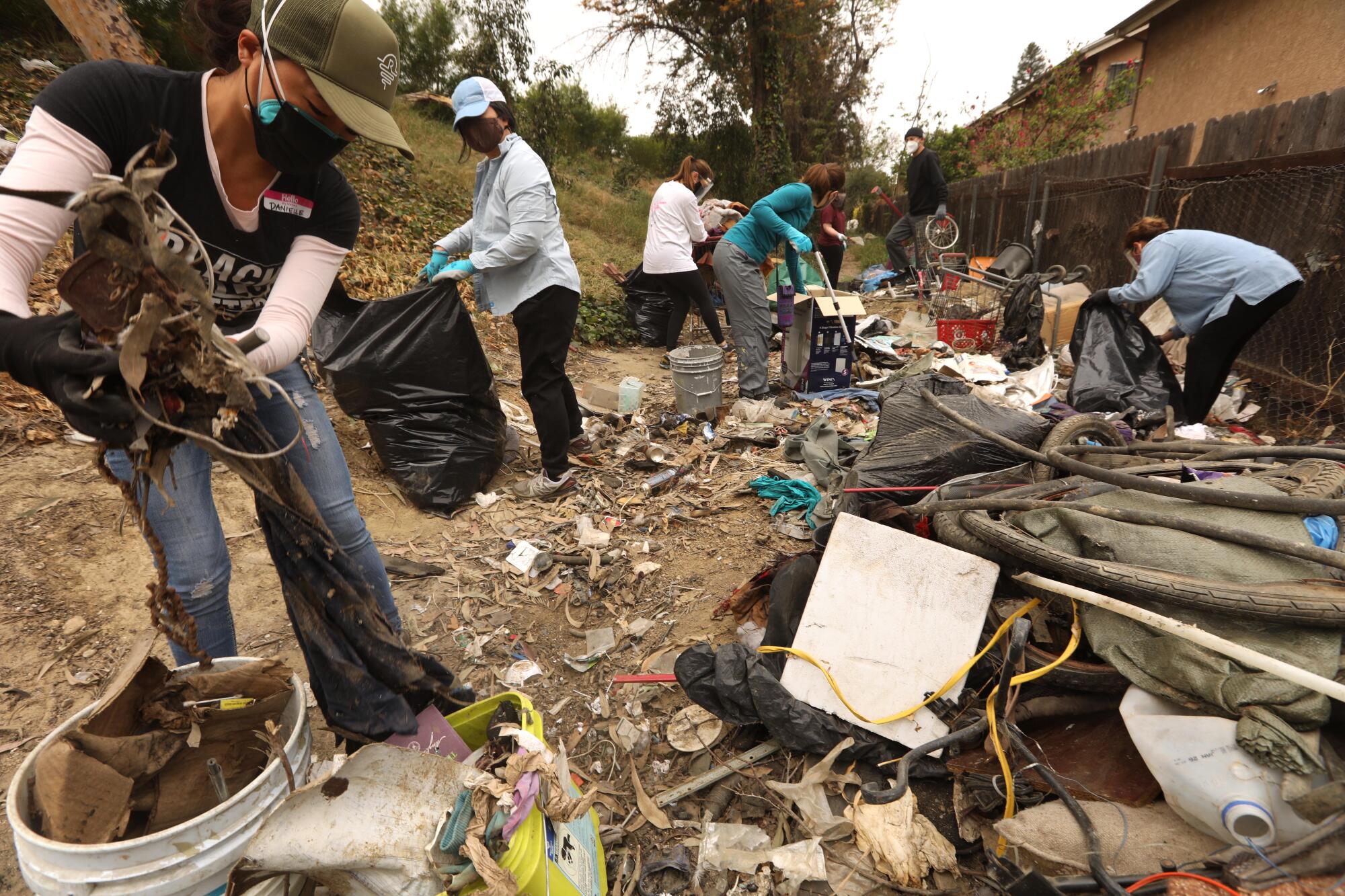
“We’re empathetic,” said Mindy Francisco, a third-grade teacher at Los Angeles Christian School who lives in a building owned by Christian nonprofit World Impact just west of its headquarters on Vermont Avenue. But, over the past year, she said, six fires have started in the homeless camps on the 10 Freeway embankment behind homes on 20th Street.
After a fire on Good Friday burned through a wooden fence behind her apartment building, Francisco and a neighbor, hospital chaplain Danielle Cummings, wrote to the city, the county and Caltrans.
Their letter, signed by 31 residents, pleaded for “cleanup efforts, fire restrictions, safe-burning receptacles, and protective walls between residents and public land.”
“We as tenants have literally fought fires away from our homes, in our yards, repaired burned fences, endured smoke and ash damage,” they wrote. “We are worried we will wake up any given night to loss of life and home.”
Then, the people of the neighborhood rolled up their sleeves on a Saturday and cleaned up the charred remnants of the makeshift shelter where the fire started.
“We’re super concerned about the people,” said Chad Wolyn, World Impact’s ministry director. “We want to help as much as we can.”
But they’re also rattled.
“We’ve heard explosions,” Wolyn said. “If it catches on one house, it catches on all houses.”
More to Read
Sign up for Essential California
The most important California stories and recommendations in your inbox every morning.
You may occasionally receive promotional content from the Los Angeles Times.














